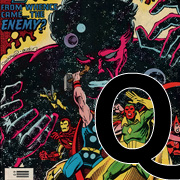 Q is for Questions: On covers, that is. While never has common as the simple declaration— “Back Off, Batman!” (The Brave and the Bold #122), for instance—questions have been an important part of selling comics to perspective buyers throughout the Silver and Bronze Ages. These range from the quotidian (“Where Are You, Girl?” (Conan #67)), to the highly pertinent (“I Know Kraven is Nearby—Waiting—Lurking—But? Where? Where?” (Daredevil #104) or “Can Anyone Save My Husband Before It’s too Late?” (Avengers #154)), to the quasi-philosophical (“What Is the Fine Line…Between Flesh and Fantasy?” (Weird War Tales #95), or “From Whence Came…The Enemy?” (Avengers #175), or “How Could Primitive Savages Overwhelm the World’s Greatest Super-Heroes?” (Justice League of America #84)), but they always served to make you want to pull issues off spinner-racks.
Q is for Questions: On covers, that is. While never has common as the simple declaration— “Back Off, Batman!” (The Brave and the Bold #122), for instance—questions have been an important part of selling comics to perspective buyers throughout the Silver and Bronze Ages. These range from the quotidian (“Where Are You, Girl?” (Conan #67)), to the highly pertinent (“I Know Kraven is Nearby—Waiting—Lurking—But? Where? Where?” (Daredevil #104) or “Can Anyone Save My Husband Before It’s too Late?” (Avengers #154)), to the quasi-philosophical (“What Is the Fine Line…Between Flesh and Fantasy?” (Weird War Tales #95), or “From Whence Came…The Enemy?” (Avengers #175), or “How Could Primitive Savages Overwhelm the World’s Greatest Super-Heroes?” (Justice League of America #84)), but they always served to make you want to pull issues off spinner-racks.Now, of course, covers are treated more pieces of art, and very little text is employed (except perhaps to say what part of what massive crossover an issue might be). The hyperbolic entreaties of the Bronze Age are seen as a somewhat cheesy relic of the past. And so I’ll pose one last question: The Lack of Cover Copy! Will It Save Comics—Or Destroy Them?
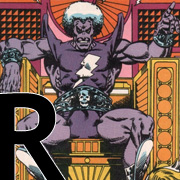 R is for Religious Overtones: Brothers and sisters, have you ever stopped to consider the way religious imagery, themes, and references emerged in comics of the Bronze Age? Please turn your attention to the gospel of Thomas and Kane found in Marvel Premiere #1 (1972) and eight issues of The Power of Warlock, and reaching its conclusion in The Incredible Hulk (vol. 2) #176-178 (1974). This, dear friends, is the Passion of Adam Warlock, as he strives to deliver Counter-Earth from evil. Also consider the Apocalypse of Jim Starlin, as he takes the erstwhile messiah figure of Warlock through the tribulations of the “Magus Saga,” beginning in Strange Tales #178 (1974). Here Warlock confronted an evil doppelganger of himself who had established an oppressive intergalactic church. Starlin would again prophesize a church gone wrong in the form of the Instrumentality, the antagonists of Dreadstar. Marvel Premiere #13-14 (1974) offer us further revelation with Doctor Strange bearing witness to the "shaggy god" story of the anagramic Sise-Neg. And can not we all take solace in “the friend” who came to that sinner Johnny Blaze in his darkest hour (Ghost Rider #9, 1974)? We must, however, not fall prey to the false message of Ghost Rider #19, which proclaimed the friend to be a demonic lie--in conflict with Brother Tony Isabella’s original intention.
R is for Religious Overtones: Brothers and sisters, have you ever stopped to consider the way religious imagery, themes, and references emerged in comics of the Bronze Age? Please turn your attention to the gospel of Thomas and Kane found in Marvel Premiere #1 (1972) and eight issues of The Power of Warlock, and reaching its conclusion in The Incredible Hulk (vol. 2) #176-178 (1974). This, dear friends, is the Passion of Adam Warlock, as he strives to deliver Counter-Earth from evil. Also consider the Apocalypse of Jim Starlin, as he takes the erstwhile messiah figure of Warlock through the tribulations of the “Magus Saga,” beginning in Strange Tales #178 (1974). Here Warlock confronted an evil doppelganger of himself who had established an oppressive intergalactic church. Starlin would again prophesize a church gone wrong in the form of the Instrumentality, the antagonists of Dreadstar. Marvel Premiere #13-14 (1974) offer us further revelation with Doctor Strange bearing witness to the "shaggy god" story of the anagramic Sise-Neg. And can not we all take solace in “the friend” who came to that sinner Johnny Blaze in his darkest hour (Ghost Rider #9, 1974)? We must, however, not fall prey to the false message of Ghost Rider #19, which proclaimed the friend to be a demonic lie--in conflict with Brother Tony Isabella’s original intention.The Distinguished Competition was more on preaching fire and brimstone than longhaired, spiritual friends. The power of good was not as much apparent, but the snares of Satan were revealed in lurid detail in their various horror titles. Even amidst this darkness, however, there are glimmers of hope. Steve Englehart was so moved by the good news of the coming of the celestial messiah that he took the tale of Mantis, an earthwoman who becomes the Celestial Madonna, from the pages of the Avengers, to Justice League of America #142 where she appears under the name Willow! In Christmas-themed, Batman #219, the Dark Knight singing “Silent Night” is shown to have the power to stop crime. Hallelujah!
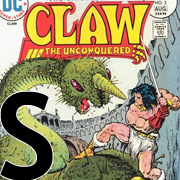 S is for Swords: Sometimes with sorcery, sometimes without. The pro-(or anti-, I guess)-sorcery pulp adaptation crowd got their roll-call in a previous BAS, but then there are the original comics creations. DC’s Showcase #82 (1969) threw its lot in with the S&S camp with its cover blurb for the debut of Nightmaster. Jim Rook, the titular Nightmaster, basically lived Ronnie James Dio’s fondest dream, as he transformed from rock ‘n’ roll front-man to heroic wielder of the Sword of Night in the world of Myrra. Nightmaster played a new riff on the “fighting man transported to exotic world” Burroughs standard. Heroes to follow would cut closer to the John Carter type. Air Force Captain Travis Morgan was certainly a more likely hero--but not necessarily one you’d expect to wear fur loincloth. Yet that’s exactly what he attached his scabbard to as the Warlord. John Jameson was another military man who became the champion of an Other Realm, only he got a wolf-man makeover and a sword as Stargod (Marvel Premiere #45). Major Christopher Summers, yet another member of the USAF, got abducted by aliens, and became a swashbuckling space-pirate with the Starjammers, debuting in X-Men #104. Arak, Son of Thunder, took a shorter trip that these other guys-- only going from pre-Columbian North America to the Court of Charlemagne--but he was every bit a man in a world not his own—and just as much the sword-swinging hero.
S is for Swords: Sometimes with sorcery, sometimes without. The pro-(or anti-, I guess)-sorcery pulp adaptation crowd got their roll-call in a previous BAS, but then there are the original comics creations. DC’s Showcase #82 (1969) threw its lot in with the S&S camp with its cover blurb for the debut of Nightmaster. Jim Rook, the titular Nightmaster, basically lived Ronnie James Dio’s fondest dream, as he transformed from rock ‘n’ roll front-man to heroic wielder of the Sword of Night in the world of Myrra. Nightmaster played a new riff on the “fighting man transported to exotic world” Burroughs standard. Heroes to follow would cut closer to the John Carter type. Air Force Captain Travis Morgan was certainly a more likely hero--but not necessarily one you’d expect to wear fur loincloth. Yet that’s exactly what he attached his scabbard to as the Warlord. John Jameson was another military man who became the champion of an Other Realm, only he got a wolf-man makeover and a sword as Stargod (Marvel Premiere #45). Major Christopher Summers, yet another member of the USAF, got abducted by aliens, and became a swashbuckling space-pirate with the Starjammers, debuting in X-Men #104. Arak, Son of Thunder, took a shorter trip that these other guys-- only going from pre-Columbian North America to the Court of Charlemagne--but he was every bit a man in a world not his own—and just as much the sword-swinging hero.Then, there were the swordsmen (and women) that didn’t have to leave home. Ironwolf’s whole improbable, wooden-spaceship-flying civilization buckled swashes in the pages of Weird Worlds #8-10. Starfire swung her sword for her world’s freedom from the alien Mygorg and Yorg for exactly 8 issues of her self-titled series. Claw the Unconquered had a demon’s hand from another world, but he mostly wandered around his native Pytharia—which turns out to be Starfire’s world in a different era.
Most these of these swords-people, and others I didn’t mentioned, succumbed to a foe swifter than their blades--and deadlier, too. Ever-fickle reader tastes sheathed many a sword, and sent their wielders to the comics Valhalla of back-issue longboxes.
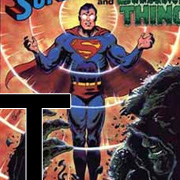 T is for Team-Ups: Throughout politically turbulent Bronze Age seventies, people were coming together for a cause—to beat up super-villains. We’d had social clubs before (the Justice Society), formal teams (the Justice League, the Avengers), and buddies hanging out (Batman and Superman in World’s Finest), but the Bronze Age real perfected the more egalitarian, one-off formula. The Brave and the Bold got the ball rolling pre-Bronze Age with issue 50, and shifted to its “Batman plus one” formula by #67. By the 70s though, Batman was dealing out justice with anybody and everybody, from a dream team-up with Scalphunter, to multiple tours with Sgt. Rock, to brief alliances with members of his rogue’s gallery (the Joker and the Riddler).
T is for Team-Ups: Throughout politically turbulent Bronze Age seventies, people were coming together for a cause—to beat up super-villains. We’d had social clubs before (the Justice Society), formal teams (the Justice League, the Avengers), and buddies hanging out (Batman and Superman in World’s Finest), but the Bronze Age real perfected the more egalitarian, one-off formula. The Brave and the Bold got the ball rolling pre-Bronze Age with issue 50, and shifted to its “Batman plus one” formula by #67. By the 70s though, Batman was dealing out justice with anybody and everybody, from a dream team-up with Scalphunter, to multiple tours with Sgt. Rock, to brief alliances with members of his rogue’s gallery (the Joker and the Riddler).Spider-Man, never a team player (well, not until recently) was perfectly willing to get by with a little help from his friends—for 150 issues in Marvel Team-Up. The strangest of these might be issue #74 (1978) where Spidey fought the Silver Samurai with the cast of Saturday Night Live, but I think another strong contender would be issue #79, when he takes on Hyborian Age heavy, Kulan Gath, with Mary Jane Watson—who’s been turned into Red Sonja by a magic sword! After Team-Up, Marvel went team-up crazy. It was clobberin’ time for two with the Thing and a new guest star every month in Marvel Two-in-One. Starting in 1975, Super-Villain Team-Up doubled your pleasure (and your dose of pontification) with Dr. Doom and Sub-Mariner. The first superhero was a little late to the Bronze Age team-up game. DC Comics Presents, featuring Superman, started in 1978 and closed out the era in 1986. In that 97 issue and 4 annual span, Supes joined forces with everybody from Ambush Bug (#81) to Mattel’s He-Man (#47). Leave it to Superman to get little “me” time in a team-up book--with two outings with Clark Kent (#59 and #79) and his Earth-Two counterpart (Annuals #1 and 3)!
In the Bronze Age team-ups like these were a monthly regularity. Now they’re often billed as capital “E” events, and seem more geared to boost sales with a walk-on than catch us up on what Kamandi’s up to in Earth After-Disaster. Team-up comics often didn’t make much sense, but they were always fun.
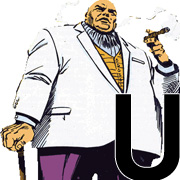 U is for Underworld: As crime-rates soared in New York and other American cities in the seventies and early eighties, film began to reflect this reality, and so did comics. A greater emphasis was put on somewhat more “realistic” criminal types rather than cackling mad scientist and soliloquizing monarchs. But it took a while. Marvel introduced the Maggia—their version of the mafia (were they afraid of having to pay royalties?)—in 1970, which were mostly Prohibition-era organized crime stereotypes and costumed cronies. Hammerhead, debuting in Spider-Man #113, was the very definition of cartoonish, with his Dick Tracy rogues’ gallery physiognomy. The gritty, Mack Bolan-inspired Punisher first appeared in 1974, but he was initially squaring off against super-villains. In 1976’s Spider-Man #162, though, he took aim at Jigsaw--who was still a little on the Dick Tracy side, but filtered through a smudged, seventies lens. When Frank Miller took over Daredevil in the early eighties, the gritty modern age was almost ready to kick in the door. The Kingpin returned in Daredevil #170, and started acting more like a “realistic” crime boss. In 1982, a little over a year later, the Punisher appeared with more Taxi Driver or Death Wish portrayal, putting Daredevil between his guns and the criminals.
U is for Underworld: As crime-rates soared in New York and other American cities in the seventies and early eighties, film began to reflect this reality, and so did comics. A greater emphasis was put on somewhat more “realistic” criminal types rather than cackling mad scientist and soliloquizing monarchs. But it took a while. Marvel introduced the Maggia—their version of the mafia (were they afraid of having to pay royalties?)—in 1970, which were mostly Prohibition-era organized crime stereotypes and costumed cronies. Hammerhead, debuting in Spider-Man #113, was the very definition of cartoonish, with his Dick Tracy rogues’ gallery physiognomy. The gritty, Mack Bolan-inspired Punisher first appeared in 1974, but he was initially squaring off against super-villains. In 1976’s Spider-Man #162, though, he took aim at Jigsaw--who was still a little on the Dick Tracy side, but filtered through a smudged, seventies lens. When Frank Miller took over Daredevil in the early eighties, the gritty modern age was almost ready to kick in the door. The Kingpin returned in Daredevil #170, and started acting more like a “realistic” crime boss. In 1982, a little over a year later, the Punisher appeared with more Taxi Driver or Death Wish portrayal, putting Daredevil between his guns and the criminals.DC had a different approach, but saw similar changes. The Black Spider from Detective Comics #463 (1976) was a former small-time crook and heroin addict that waged a vigilante war against the “Pusher-Man.” Six issues later, Rupert Thorne, a Boss Tweed-style corrupt city boss, became a—uh, well you know—in Batman’s side. Just a month earlier, Black Lightning #1 had introduced DC’s own kingpin of Metropolis, Tobias Whale.
Editor's Note: If you enjoyed that, be sure to check out more of Trey's musings over at the From The Sorceror's Skull.
Have a great weekend!

1 comment:
Thanks for keeping these going.
Post a Comment